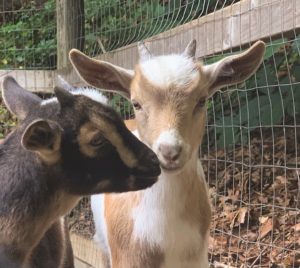Goats have horns. That’s something I always took for granted. I grew up seeing goats on mountaintops throughout my childhood in Austria, and every one of them had horns. But when we picked up our first baby goats four years ago, they had smooth heads. Puzzled, I asked their seller at what age they would grow horns. They wouldn’t, I was told. Our kids had been “disbudded.”
In all breeds of goats, both males and females have horns for reasons connected to their survival. They come into play when goats butt for territory and breeding rights and they can help a goat defend itself from predators. But what’s less obvious is that horns are also crucial to a goat’s temperature regulation: excess body heat is carried to the horn’s dense network of blood vessels and released. Goats without horns pant to cool off, but that doesn’t do the job as well as their horns would have been. They don’t tolerate heat well.
The practice of removing horns from goats developed with domestication. Goats without horns are easier to handle in large numbers on dairy farms. An angry or threatened goat can injure farm workers or other animals. Goats without horns are also less likely to get tangled in hay feeders or fences.

The price of practicality, though, is high. Goats have been bred to be polled — born hornless. But in the last century, farmers came to understand that the practice led to genetic complications including hermaphroditism, which is not great if a goal of your farming is milk and cheese production.
Instead, disbudding has become common practice: the kids’ budding horns are burned with a hot iron soon after birth, destroying all the cells that promote further growth of horn tissue.
A goat’s horn consists of a bony core covered in keratin, the same material our human hair and fingernails are made of. Horns, however, more closely resemble our teeth than our hair or fingernails, in that they are alive with blood vessels and nerves. So, the procedure can be painful, and, if it’s not done properly, the kid can suffer permanent scarring, brain damage, or even death. One of our goats, Lance Romance, came to us with a thick scar on the top of his head where his skull was burned in a botched disbudding procedure.
An alternative to disbudding, for older animals, is dehorning. Suffice it to say the procedure is riskier and more controversial than debudding, though both practices — which are not regulated in the U.S. — are increasingly being reconsidered.
For backyard farmers, the choice is perhaps not as complex as it is on large-scale farms. Those who choose to disbud new kids can see that the job is done by a good vet who will use anesthesia and post-procedure medications to help the newborn goat recover quickly.
Since we’re raising just a few goats for company as much as for milk, the pain and risk of debudding don’t seem worth it to us. Our approach is to treat our goats with kindness and love, but also awareness of their instincts, and willingness to show them a healthy amount of assertiveness.
Our new kids will soon sport the small, slightly curved horns characteristic of their Nigerian Dwarf breed. We look forward to seeing their handsome headdresses take shape.



